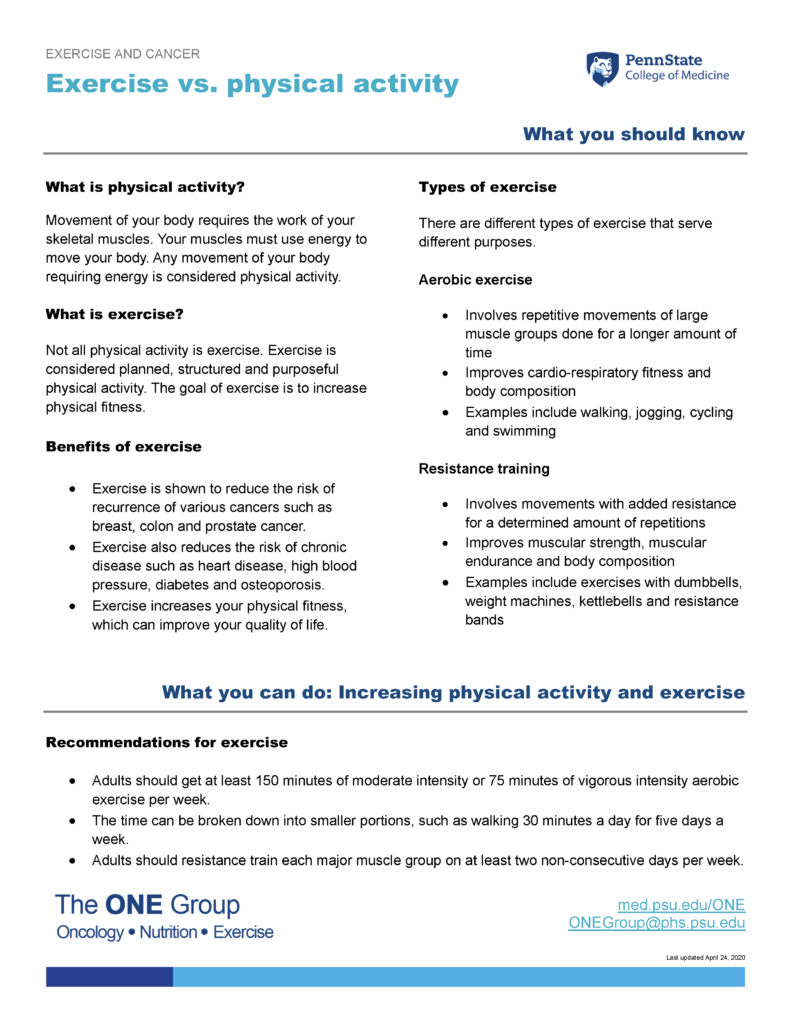Learn about exercise vs. physical activity in this guide from The ONE Group (Oncology – Nutrition – Exercise) at Penn State College of Medicine.
Jump to topic
Search
What you should know
What is physical activity?
Movement of your body requires the work of your skeletal muscles. Your muscles must use energy to move your body. Any movement of your body requiring energy is considered physical activity.
What is exercise?
Not all physical activity is exercise. Exercise is considered planned, structured and purposeful physical activity. The goal of exercise is to increase physical fitness.
Benefits of exercise
- Exercise is shown to reduce the risk of recurrence of various cancers such as breast, colon and prostate cancer.
- Exercise also reduces the risk of chronic disease such as heart disease, high blood pressure, diabetes and osteoporosis.
- Exercise increases your physical fitness, which can improve your quality of life.
Types of exercise
There are different types of exercise that serve different purposes.
Aerobic exercise
- Involves repetitive movements of large muscle groups done for a longer amount of time
- Improves cardio-respiratory fitness and body composition
- Examples include walking, jogging, cycling and swimming
Resistance training
- Involves movements with added resistance for a determined amount of repetitions
- Improves muscular strength, muscular endurance and body composition
- Examples include exercises with dumbbells, weight machines, kettlebells and resistance bands
What you can do: Increasing physical activity and exercise
Recommendations for exercise
- Adults should get at least 150 minutes of moderate intensity or 75 minutes of vigorous intensity aerobic exercise per week.
- The time can be broken down into smaller portions, such as walking 30 minutes a day for five days a week.
- Adults should resistance train each major muscle group on at least two non-consecutive days per week.
Exercise during cancer treatment
During cancer treatment, a reduced amount of exercise can still be helpful in improving common symptoms. Try 30 minutes of aerobic exercise three times a week, plus twice-weekly strength training, to improve fatigue, quality of life, physical function, sleep and bone health and reduce anxiety and depression.
Five components of physical fitness
- Cardio-respiratory fitness
- Muscular strength and endurance
- Agility
- Flexibility
- Balance
Tips to increase daily physical activity
- Stand more and sit less.
- Limit screen time throughout the day.
- Participate in sports or fitness activities.
- Make exercise a habit – make an appointment with yourself to exercise regularly.
Ways to add movement into your day
- Rearrange your work desk to be a standing desk.
- Park farther away from building entrances.
- Take the stairs instead of elevators and escalators.
- Ride a stationary bike while watching television.
Where can I find more information about aerobic and strength-training exercises?
If you are interested in starting aerobic and/or strength-training exercises, The ONE Group (Oncology – Nutrition – Exercise) provides videos demonstrating proper form for more than 50 exercises.
Notes
References
- ACE Fitness
- American Cancer Society
- American Society of Clinical Oncology

